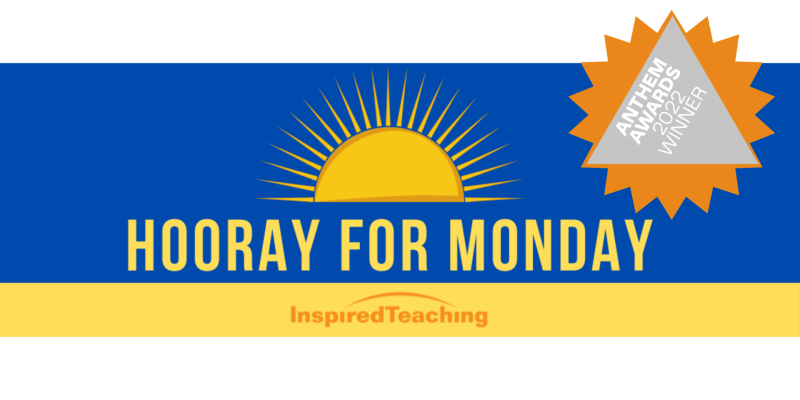By Aleta Margolis, Founder and President, Center for Inspired Teaching
Hooray for Monday is a weekly blog filled with questions, ideas, reflections, and actions we can all take to remodel the school experience for students.
 As educators, it’s our job to find out what our students need, and strive to meet those needs. This critical aspect of supporting students’ social and emotional learning (SEL) has been the focus of my posts these past few weeks, as I’ve shared Inspired Teaching’s ABCDE of Learner Needs – a tool designed to help teachers address root causes of problems.
As educators, it’s our job to find out what our students need, and strive to meet those needs. This critical aspect of supporting students’ social and emotional learning (SEL) has been the focus of my posts these past few weeks, as I’ve shared Inspired Teaching’s ABCDE of Learner Needs – a tool designed to help teachers address root causes of problems.
However, this doesn’t mean we think of our students only in terms of their needs. As I wrote this fall in an article about redefining learning loss, if our starting point is the search for deficits, we are likely to limit ourselves, and therefore our students. If you look only for problems, you will find only problems.
This works in reverse too. If you switch the context and start by looking for assets, you will find assets. When thinking about who our students are, and who they have the potential to be as learners, it’s wise to start with their aspirations and contributions.

This is the central thesis of the work of Trabian Shorters, an activist, author, and social entrepreneur who is sparking a national movement to use asset framing when we think about how to help people. In a recent episode of On Being, Trabian describes asset framing as “defining people by their aspirations and contributions, before you get to their challenges…So whatever is going on in someone’s life, you don’t ignore it, but you don’t define them by the worst moment or the worst experience or the worst potential; none of that. You have to look past their faults, to see who they really are.“
This is critically important for all children, but especially for Black children who, as Trabian points out, are far more likely than their white peers to be defined in school and in other parts of life by their deficits than by their assets.
In order to define a student by their “aspirations and contributions,” you have to find out what their aspirations and contributions are! This somewhat obvious realization has the power to transform the way we approach our jobs as educators.
And this mindshift can be powerful for our students as well. They can build their empathy for others, set and achieve their own goals, and make informed decisions when they become aware of their own aspirations and contributions. Building this awareness is a powerful way to support students’ socioemotional learning, as well as their academic learning.
Trabian recommends taking a “100-day challenge” and trying to adopt an asset framing perspective in all aspects of your life. That means intentionally thinking about all the people around you in terms of their aspirations and contributions before you consider their challenges. “Honestly, when you start practicing asset-framing, your life gets better. You feel better. You see more life, you see more light, in your day-to-day. You’re more forgiving of people who have faults and flaws.”
The old adage is true: You find what you look for. I invite you to challenge yourself this week to look for the aspirations and contributions in your students and in yourself. You’re sure to find something beautiful.
COLLABORATIVE FOR ACADEMIC, SOCIAL, AND EMOTIONAL LEARNING COMPETENCIES
As you think about applying Asset Framing in your school context, consider the ways in which this approach can nurture the CASEL competencies at the heart of Social and Emotional Learning.
Collaborative for Academic, Social, and Emotional Learning Competencies
Self-Awareness: The abilities to understand one’s own emotions, thoughts, and values and how they influence behavior across contexts. This includes capacities to recognize one’s strengths and limitations with a well-grounded sense of confidence and purpose.
Self-management: The abilities to manage one’s emotions, thoughts, and behaviors effectively in different situations and to achieve goals and aspirations. This includes the capacities to delay gratification, manage stress, and feel motivation and agency to accomplish personal and collective goals.
Social awareness: The abilities to understand the perspectives of and empathize with others, including those from diverse backgrounds, cultures, and contexts. This includes the capacities to feel compassion for others, understand broader historical and social norms for behavior in different settings, and recognize family, school, and community resources and supports.
Responsible decision-making: The abilities to make caring and constructive choices about personal behavior and social interactions across diverse situations. This includes the capacities to consider ethical standards and safety concerns, and to evaluate the benefits and consequences of various actions for personal, social, and collective well-being.
Relationship skills: The abilities to establish and maintain healthy and supportive relationships and to effectively navigate settings with diverse individuals and groups. This includes the capacities to communicate clearly, listen actively, cooperate, work collaboratively to problem solve and negotiate conflict constructively, navigate settings with differing social and cultural demands and opportunities, provide leadership, and seek or offer help when needed.
